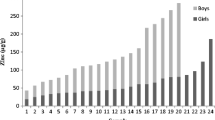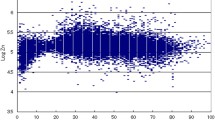Summary
Hair zinc has been investigated in children of North and South Libya. The hair zinc content amounts to 213±36 μg/g in newborns. There is no difference between the values of newborns from North Libya and newborns from South Libya. The hair zinc values decrease during infancy. In toddlers and school-children the hair zinc content is 88±35 μg/g, 89±25 μg/g resp. These values are as low as those reported in American children with low height percentiles or nearly as low as those found in dwarfs with poor zinc status from Egypt and Iran.
Zusammenfassung
Der Haarzinkgehalt wurde in Haaren von Kindern aus Nord- und Südlibyen bestimmt. Der Zinkgehalt betrug 213±36 μg/g bei libyschen Neugeborenen. Es bestand kein Unterschied zwischen den Werten von Neugeborenen aus Nord- und Südlibyen. Der Zinkgehalt fällt während der Säuglingszeit ab. Bei Klein- und Schulkindern lag der Zinkgehalt bei 88±35 μg/g bzw. 89±25 μg/g. Diese Werte sind so niedrig wie die bei amerikanischen kleinwüchsigen Kindern oder fast so niedrig wie bei den ägyptischen und persischen Zwergen mit vermindertem Zincstatus.
Similar content being viewed by others
References
Arunachalam, J., S. Gangadharan, S. Yegnasubramanian: Elemental data on human hair samples from Indian student population and their interpretation for studies in environmental exposure. International Atomic Energy Agency, Wien, SM 227/24 (1978).
Baumslag, N., D. Yaeger, L. Levin, H. G. Petering: Trace metal content of maternal and neonate hair. Zinc, copper, iron and lead. Arch. Environ. Health29, 186 (1974).
McBean, L. D., M. Mahloudji, J. G. Reinhold, J. A. Halsted: Correlation of zinc concentrations in human plasma and hair. Amer. J. Clin. Nutr.24, 506 (1971).
Casey, C. E., K. M. Hambidge: Trace element deficiencies in man. Adv. Nutr. Res.3, 23 (1980).
Clemente, G. F., L. C. Rossi, G. P. Santaroni: Trace element composition of hair in the Italian population. International Atomic Energy Agency, Wien, SM 227/13 (1978).
Gershoff, S. N., R. B. McGandy, A. Nondasuta, U. Pisolyabatura, P. Tantiwongse: Nutrition studies in Thailand. III. Trace minerals in human and rat hair. Amer. J. Clin. Nutr.30, 868 (1977).
Halsted, J. A., J. C. Smith, M. I. Irwin: A conspectus of research on zinc requirements of man. J. Nutr.104, 345 (1974).
Hambidge, K. M., C. Hambidge, M. Jacobs, J. D. Baum: Low levels of zinc in hair, anorexia, poor growth, and hypogeusia in children. Pediat. Res.6, 868 (1972).
Hambidge, K. M., P. A. Walravens, R. M. Brown, J. Webster, S. White, M. Anthony, M. L. Roth: Zinc nutrition of preschool children in the Denver head start program. Amer. J. Clin. Nutr.29, 734 (1976).
Heinersdorf, H., T. G. Taylor: Concentration of zinc in the hair of school children. Arch. Dis. Childn.54, 958 (1979).
Jervis, R. E.: Applications of activation analysis in forensic science. International Atomic Energy Agency (Amsterdam 1967).
Kasperek, K., V. Siller, L. E. Feinendegen: Aktivierungsanalyse von Spurenelementkonzentrationen im menschlichen Kopfhaar: Einfluß von Geschlecht, Alter und Umwelt. Erg. Klin. Nukl. Med., Suppl.9, 123 (1971).
Kasperek, K.: Analytical techniques for the determination of 20 trace elements in biological samples by means of instrumental thermal neutron activation analysis. In: Proc. of the 2nd Internat. Conf. on Nuclear Methods in Environmental Research. U.S. Energy Research and Development Administration, Conf. 740701 (1974).
Kleavy, L. M.: Hair as a biopsy material. I. Assessment of zinc nutriture. Amer. J. Clin. Nutr.23, 284 (1970).
McKenzie, J. M.: Alteration of the zinc and copper concentration of hair. Amer. J. Clin. Nutr.31, 470 (1978).
Reinhold, J. G., G. A. Kfoury, M. A. Ghalambor, J. C. Bennett: Zinc and copper concentrations in hair of Iranian villagers. Amer. J. Clin. Nutr.18, 294 (1966).
Sakurai, S., H. Tsunoda, M. Terai, M. Yukawa, K. Tomura, M. Suzuki-Yasumoto: A study of trace element concentrations in human hair of some local populations in Japan. II. Inhabitants of a Japanese rural area. International Atomic Energy Agency, Wien, SM-227/16 (1978).
Sarram, M., M. Younessi, P. Khorvash, G. A. Kfoury, J. G. Reinhold: Zinc Nutrition in human pregnancy in Fars province, Iran. Amer. J. Clin. Nutr.22, 726 (1969).
Strain, W. H., L. T. Steadman, C. A. Lankau, Jr., W. P. Berliner, W. J. Pories: Analysis of zinc levels in hair for the diagnosis of zinc deficiency in man. J. Lab. Clin. Med.68, 244 (1966).
Strain, W. H., A. Lacari, W. J. Pories: Zinc deficiency in babies. Proc. Seventh Internat. Congr. Nutr. 1 (1966).
Walravens, P. A., K. M. Hambidge: Growth of infants fed a zinc supplemented formula. Amer. J. Clin. Nutr.29, 1114 (1976).
Author information
Authors and Affiliations
Rights and permissions
About this article
Cite this article
Lombeck, I., Al-Zubaidy, I.M., Kasperek, K. et al. Zinc status of Libyan children — a pilot study. Z Ernährungswiss 22, 1–5 (1983). https://doi.org/10.1007/BF02020779
Received:
Published:
Issue Date:
DOI: https://doi.org/10.1007/BF02020779




